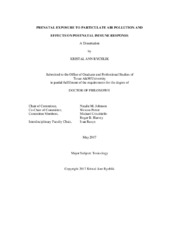| dc.description.abstract | There is considerable evidence showing that exposure to particulate matter air pollution during important developmental windows, such as the prenatal period, can cause adverse respiratory outcomes. Mechanisms underlying increased risks from in utero exposure are largely unknown. Since epigenetic modifications have been recognized as an important mediator of developmental reprogramming following environmental exposures in early life, the primary objective of this research was to establish a representative model of prenatal air pollution exposure to probe underlying mechanisms leading to adverse respiratory responses in offspring. The preliminary study (aim 1) established the proof-of-principle for differential air pollution-induced epigenetic changes across varying genetic background. Two strains (BALB/c and C57Bl/6 mice) were exposed to diesel exhaust particulate matter (DEPM), a major constituent of outdoor air pollution, throughout pregnancy. Following sacrifice at postnatal day 2, offspring global DNA methylation and hydroxymethylation was quantified in lung tissue. Results indicate differential methylation in BALB/c mice but not C57Bl/6. In aim 2, BALB/c and C57Bl/6 dams were exposed to a representative particulate air pollution mixture throughout gestation using a refined exposure model, and offspring response to allergen challenge was evaluated. After 4 weeks of chronic exposure to house dust mite allergen, offspring from both strains exposed to PM in utero demonstrated a reduced inflammatory response compared to filtered air controls. Airway hyperresponsiveness, a typical feature of asthma, was significantly different based on strain; however, air pollution exposure did not affect this response. In order to investigate the relevance of this model in an exposed human population, we conducted a pilot project (aim 3) evaluating exposure to particulate air pollution during pregnancy in a region in South Texas with a high incidence of childhood asthma. Results demonstrate low levels of air pollution exposure during pregnancy measured by personal sampling of fine particulate matter (PM2.5) and polycyclic aromatic hydrocarbons (PAHs). Overall, findings from this work lay a foundation for further clarifying the mechanisms underlying childhood respiratory disease resulting from early life air pollution exposure. | en |


